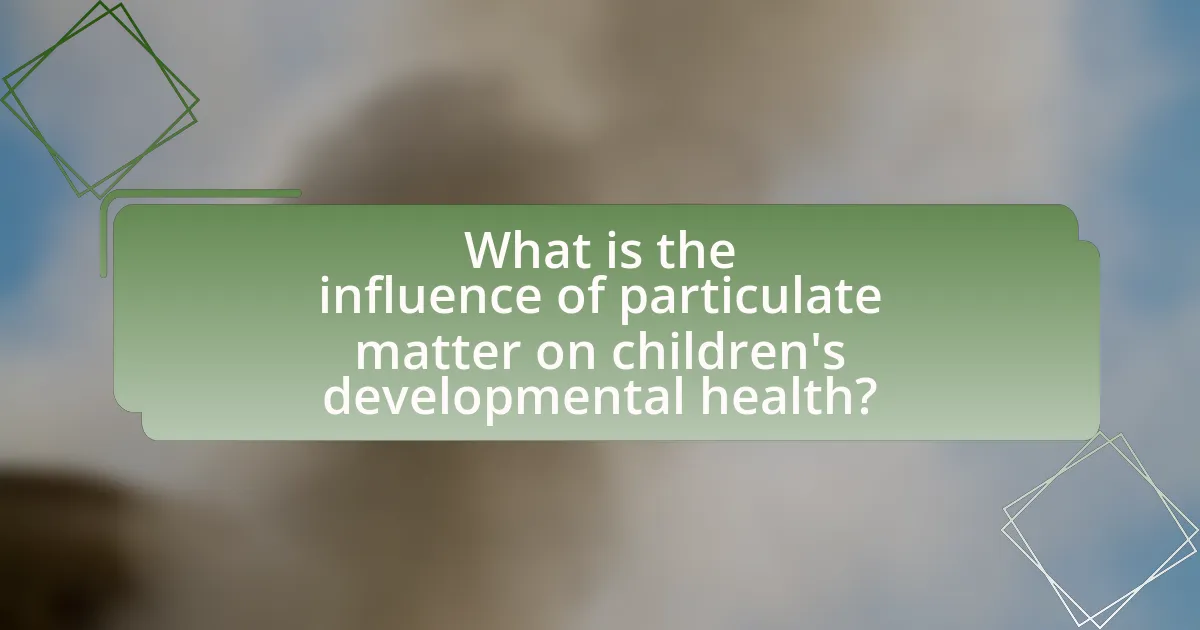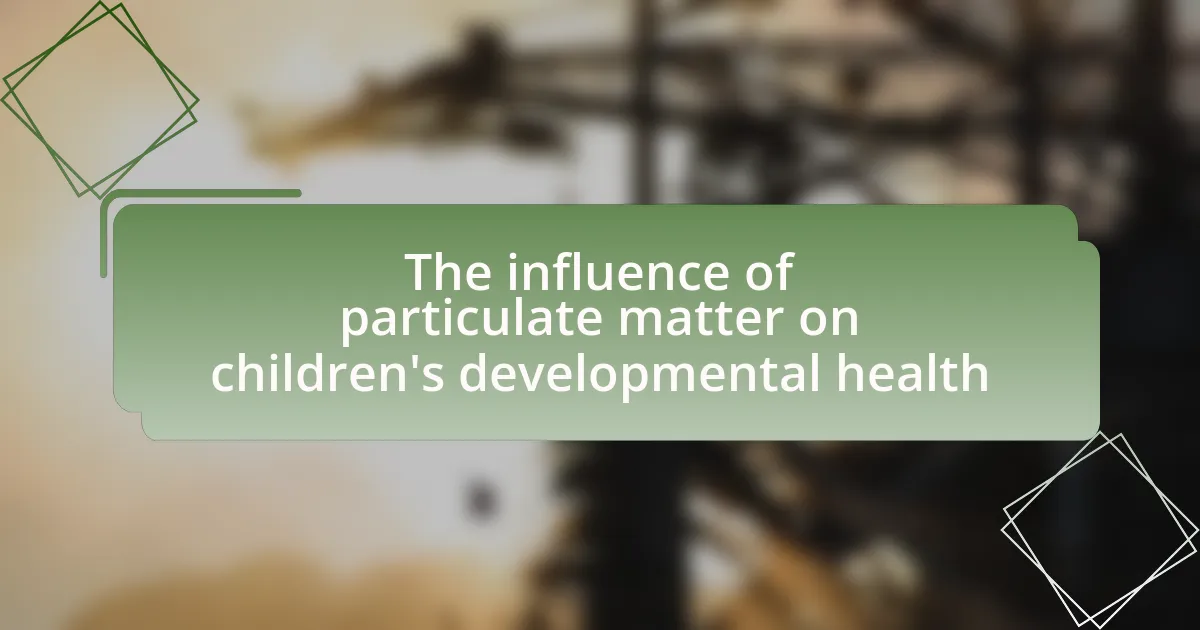Particulate matter (PM) significantly impacts children’s developmental health, leading to cognitive impairments and increased risks of respiratory and cardiovascular diseases. Research indicates that exposure to fine particulate matter (PM2.5) is linked to lower IQ levels and developmental delays, particularly during prenatal and early childhood stages. The article explores the types of particulate matter, the mechanisms of exposure, and the long-term health consequences for children, emphasizing the need for effective mitigation strategies. It also highlights the role of parents, caregivers, and communities in reducing exposure and improving air quality to protect children’s health.
What is the influence of particulate matter on children’s developmental health?

Particulate matter negatively influences children’s developmental health by impairing cognitive function and increasing the risk of respiratory and cardiovascular diseases. Studies have shown that exposure to fine particulate matter (PM2.5) is associated with lower IQ levels and developmental delays in children. For instance, research published in the journal Environmental Health Perspectives found that children living in areas with high levels of PM2.5 exhibited significant deficits in cognitive abilities compared to those in cleaner environments. Additionally, the World Health Organization reports that air pollution, including particulate matter, contributes to approximately 1.7 million deaths in children under five each year, highlighting its severe impact on health outcomes.
How does particulate matter affect children’s health?
Particulate matter adversely affects children’s health by increasing the risk of respiratory issues, cardiovascular problems, and developmental delays. Studies indicate that exposure to fine particulate matter (PM2.5) can lead to asthma, reduced lung function, and increased hospital visits for respiratory infections among children. Research published in the journal “Environmental Health Perspectives” highlights that children living in areas with high levels of air pollution, including particulate matter, are more likely to experience cognitive impairments and behavioral issues. Furthermore, the World Health Organization reports that air pollution is a significant environmental risk factor for children’s health, emphasizing the need for effective measures to reduce exposure.
What are the different types of particulate matter?
Particulate matter (PM) is categorized into several types based on size and composition. The main types include PM10, which consists of particles with a diameter of 10 micrometers or smaller, and PM2.5, which includes finer particles with a diameter of 2.5 micrometers or smaller. These classifications are significant because PM2.5 can penetrate deeper into the respiratory system, posing greater health risks, particularly to children. Research indicates that exposure to PM2.5 is linked to adverse developmental outcomes in children, including respiratory issues and cognitive impairments.
How does exposure to particulate matter occur in children?
Exposure to particulate matter occurs in children primarily through inhalation of contaminated air. Children are particularly vulnerable due to their higher respiratory rates and time spent outdoors, especially in urban areas with heavy traffic or industrial activity. Studies indicate that children living near highways or industrial sites are at increased risk of exposure, as these environments often have elevated levels of particulate matter. Additionally, indoor sources such as tobacco smoke, cooking, and heating can contribute to their exposure. Research has shown that even low levels of particulate matter can adversely affect children’s respiratory health and cognitive development, highlighting the importance of mitigating exposure in their environments.
Why is children’s developmental health particularly vulnerable to particulate matter?
Children’s developmental health is particularly vulnerable to particulate matter due to their developing respiratory and neurological systems. Research indicates that exposure to particulate matter can lead to adverse health outcomes, including impaired cognitive development and increased risk of respiratory diseases. For instance, a study published in the journal Environmental Health Perspectives found that children exposed to higher levels of particulate matter exhibited lower IQ scores and developmental delays. This vulnerability is exacerbated by children’s higher breathing rates and their tendency to spend more time outdoors, increasing their exposure to air pollutants.
What stages of development are most affected by particulate matter?
The stages of development most affected by particulate matter are prenatal and early childhood stages. Research indicates that exposure to particulate matter during pregnancy can lead to adverse outcomes such as low birth weight, preterm birth, and developmental delays. Additionally, children exposed to high levels of particulate matter in their early years are at increased risk for cognitive impairments and respiratory issues, as their lungs and brains are still developing. Studies have shown that children living in areas with elevated particulate matter levels exhibit lower IQ scores and higher rates of asthma, highlighting the significant impact of air pollution on their health and development.
How does particulate matter impact cognitive development in children?
Particulate matter negatively impacts cognitive development in children by affecting brain structure and function. Research indicates that exposure to high levels of particulate matter, particularly fine particles (PM2.5), is associated with lower IQ scores and impaired cognitive abilities. A study published in the journal Environmental Health Perspectives found that children living in areas with elevated particulate matter levels exhibited significant deficits in cognitive performance, particularly in memory and attention tasks. This correlation suggests that air pollution, specifically particulate matter, poses a serious risk to the cognitive health of developing children.
What are the long-term effects of particulate matter exposure on children?
Long-term exposure to particulate matter can lead to significant health issues in children, including respiratory problems, cardiovascular diseases, and developmental delays. Studies have shown that children exposed to high levels of particulate matter are at an increased risk for asthma, reduced lung function, and other chronic respiratory conditions. For instance, research published in the journal “Environmental Health Perspectives” indicates that children living in areas with elevated particulate matter levels exhibit a higher incidence of asthma and other respiratory illnesses. Additionally, exposure to particulate matter has been linked to cognitive impairments and lower academic performance, as highlighted in a study by the University of California, Berkeley, which found that children exposed to air pollution had lower IQ scores compared to their peers in cleaner environments.
How does early exposure to particulate matter influence future health outcomes?
Early exposure to particulate matter significantly increases the risk of developing respiratory and cardiovascular diseases later in life. Studies have shown that children exposed to high levels of particulate matter are more likely to experience reduced lung function, increased asthma prevalence, and other chronic health issues. For instance, research published in the journal “Environmental Health Perspectives” indicates that children living in areas with elevated particulate matter levels exhibit a higher incidence of respiratory illnesses and long-term health complications. This correlation underscores the critical impact of early environmental exposures on future health trajectories.
What chronic conditions are linked to particulate matter exposure in children?
Particulate matter exposure in children is linked to several chronic conditions, including asthma, respiratory infections, and cardiovascular diseases. Research indicates that children exposed to high levels of particulate matter are at an increased risk of developing asthma due to inflammation and airway hyperreactivity caused by pollutants. Additionally, studies have shown that exposure can lead to recurrent respiratory infections, as particulate matter can impair immune responses. Furthermore, long-term exposure to particulate matter has been associated with cardiovascular issues, as it can contribute to the development of atherosclerosis and other heart-related conditions in pediatric populations.
How can we mitigate the effects of particulate matter on children’s health?
To mitigate the effects of particulate matter on children’s health, implementing stricter air quality regulations is essential. Research indicates that exposure to particulate matter can lead to respiratory issues, developmental delays, and other health problems in children. For instance, the World Health Organization states that reducing particulate matter levels can significantly decrease the incidence of asthma and other respiratory diseases among children. Additionally, promoting the use of air purifiers in homes and schools can help reduce indoor particulate matter exposure. Studies show that air purifiers can lower particulate levels by up to 50%, thereby improving children’s health outcomes. Furthermore, encouraging outdoor activities during times of lower air pollution can minimize exposure, as children are particularly vulnerable to the harmful effects of air pollutants.
What role do parents and caregivers play in protecting children from particulate matter?
Parents and caregivers play a crucial role in protecting children from particulate matter by implementing strategies to minimize exposure. They can reduce indoor air pollution by using air purifiers, maintaining clean living environments, and avoiding the use of tobacco products indoors. Additionally, parents can limit outdoor activities during high pollution days, as recommended by air quality indices, to decrease children’s exposure to harmful particles. Research indicates that children are particularly vulnerable to the effects of particulate matter, which can lead to respiratory issues and developmental delays. By actively managing their children’s environment and behaviors, parents and caregivers significantly contribute to safeguarding their health against the adverse effects of particulate matter.
What practical steps can be taken to reduce children’s exposure to particulate matter?
To reduce children’s exposure to particulate matter, parents and caregivers can implement several practical steps. First, keeping windows and doors closed during high pollution days minimizes outdoor air infiltration. Additionally, using air purifiers with HEPA filters indoors can significantly decrease particulate levels. Regularly cleaning and vacuuming homes with a vacuum equipped with a HEPA filter also helps to remove settled dust and allergens. Furthermore, encouraging children to play indoors on days with poor air quality can limit their exposure. Lastly, promoting the use of public transportation or carpooling can reduce vehicle emissions, which are a major source of particulate matter. These actions collectively contribute to a healthier environment for children, thereby supporting their developmental health.
How can communities work together to improve air quality for children’s health?
Communities can work together to improve air quality for children’s health by implementing local initiatives focused on reducing pollution sources and promoting clean air practices. Collaborative efforts can include organizing tree planting campaigns, which enhance air quality by absorbing pollutants, and advocating for stricter regulations on industrial emissions, as studies show that lower emissions correlate with improved respiratory health in children. Additionally, communities can establish carpool programs and promote public transportation to decrease vehicle emissions, which are a significant contributor to air pollution. Research indicates that reducing particulate matter exposure can lead to better developmental outcomes for children, highlighting the importance of community engagement in air quality improvement efforts.
What resources are available for understanding and addressing particulate matter exposure in children?
Resources available for understanding and addressing particulate matter exposure in children include the Environmental Protection Agency (EPA), which provides guidelines and research on air quality and its effects on health. The EPA’s “Air Quality and Children’s Health” report outlines the risks associated with particulate matter exposure in children and offers strategies for mitigation. Additionally, the World Health Organization (WHO) offers resources such as the “Air Quality Guidelines,” which detail safe levels of particulate matter and their health implications. Research studies, such as “Air Pollution and Child Health: A Global Perspective” published in the journal Environmental Health Perspectives, provide evidence on the impact of particulate matter on children’s developmental health. These resources collectively offer comprehensive information for understanding and addressing the risks of particulate matter exposure in children.
What are the best practices for monitoring and improving children’s developmental health in relation to particulate matter?
The best practices for monitoring and improving children’s developmental health in relation to particulate matter include regular air quality assessments, implementing exposure reduction strategies, and promoting public awareness. Regular air quality assessments utilize monitoring stations and mobile apps to track particulate matter levels, allowing caregivers to make informed decisions about outdoor activities. Implementing exposure reduction strategies involves creating smoke-free zones, using air purifiers indoors, and ensuring proper ventilation in homes. Promoting public awareness through educational campaigns informs families about the risks of particulate matter and encourages protective behaviors, such as limiting outdoor play during high pollution days. These practices are supported by research indicating that reducing exposure to particulate matter can lead to improved respiratory health and cognitive development in children.

Leave a Reply